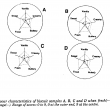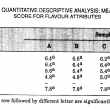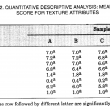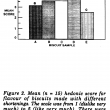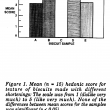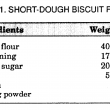Journal of Oil Palm Research Vol. 3 No. 1 1991 June, p. 302-310
USE OF PALM OIL AND BUTTERFAT AS SHORTENINGS FOR SHORT-DOUGH BISCUITS: SENSORY AND INSTRUMENTAL ANALYSIS
The purpose of this study was to evaluate the quality of short-dough biscuits made with shortenings based on palm oil and butterfat. A commercial biscuit sample was included in the study for comparison. Evaluations were carried out using a panel of judges, and attempts were made to relate panel evaluation with instrumental measurements on texture. Hedonic Rating, Texture Profiling, Flavour Profiling and Quantitative Descriptive Analysis were the sensory methods used, while the J.J. Lloyd Texture Testing Machine Model T5K ,was the instrument used for measurements of breaking strength. Differences in texture between experimental and commercial biscuit samples could be detected by the trained panels (p < 0.05). The amount of force required to break the experimental biscuits ranged from 4.2 to 5.8 Newton while a higher force (13.2 Newton) was required to break the commercial biscuit sample. There was a good correlation between trained panel evaluation and instrumental measurements. The experimental biscuits were judged to be more crispy, more crunchy, more crumbly and more gritty as compared with the commercial sample. Products made with shortenings containing palm oil and butterfat were not significantly different in flavour from those made with 100% butterfat. However, there was a significant difference in flavour (p<0.05) between experimental and commercial short-dough biscuits.
KEYWORDS:FIGURES & TABLES:
* Palm Oil Research Institute of Malaysia,
P O Box 10620,
50720 Kuala Lumpur
+ Jabatan Sains Makanan dan Pemakanan,
Fakulti Sains Hayat,
Universiti Kebangsaan Malaysia,
43600 UKM Bangi, Selangor
